Financial Performance Analysis: Lehman Brothers Case Study Report
VerifiedAdded on 2020/03/07
|12
|2851
|54
Report
AI Summary
This report provides a comprehensive analysis of the financial management of Lehman Brothers, examining the company's financial statements from 2007-2008, including income statements and balance sheets. It identifies and analyzes key financial ratios such as current, profitability, and solvency ratios, revealing the company's declining financial health leading up to its collapse. The report explores the arguments surrounding Lehman Brothers' failure, highlighting the lack of a buyer, a disastrous balance sheet, and the absence of political favor for bailouts, alongside the impact of the 2007-2008 financial crisis. It also addresses ethical considerations, such as misconduct during boom times and balance sheet manipulations, and the importance of ethical reforms. Additionally, the report considers the impact of external factors, like the sub-prime mortgage crisis, on the company's human resource management and overall operations. The analysis concludes that the subprime crisis was a major contributor to Lehman Brothers' downfall.
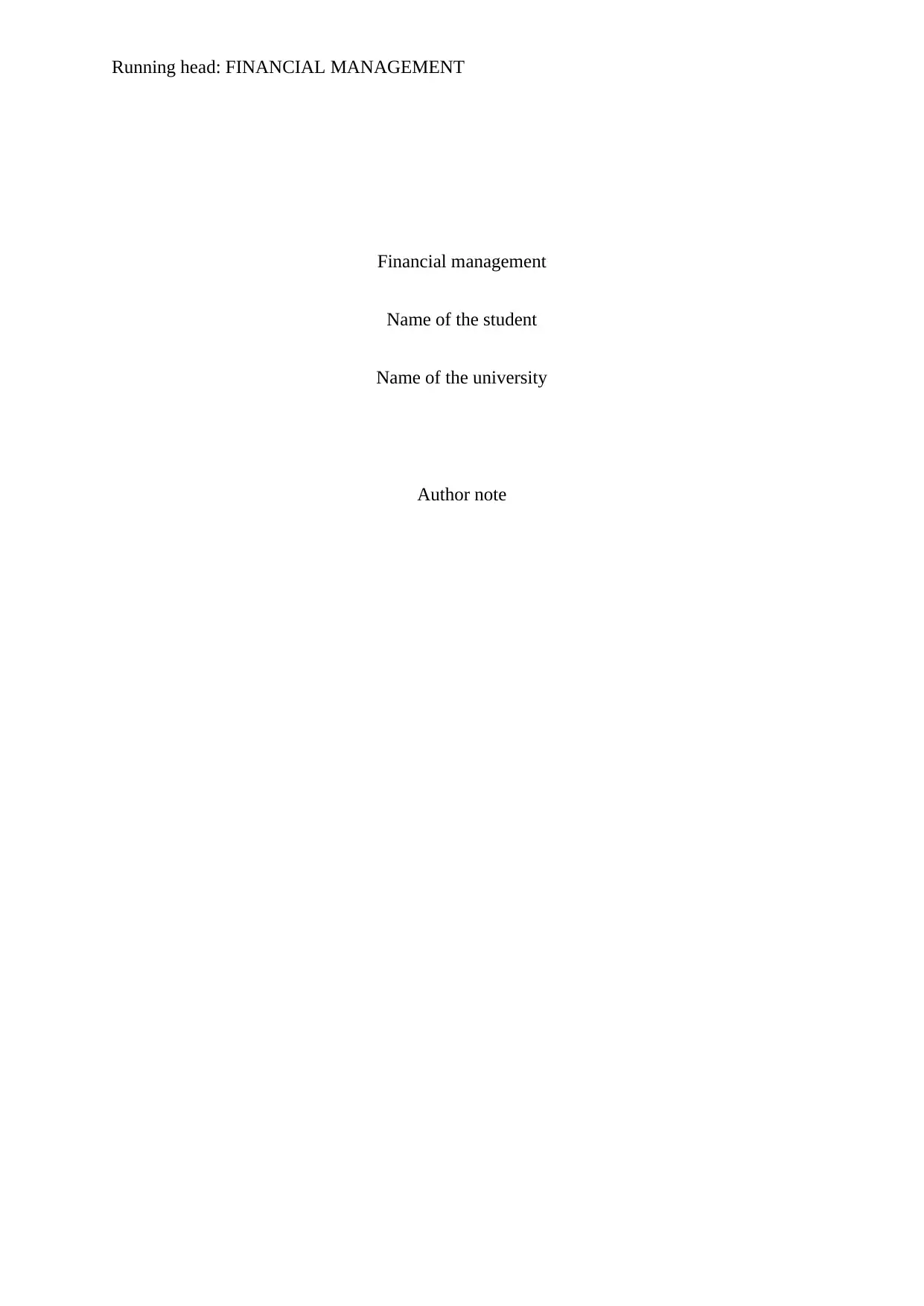
Running head: FINANCIAL MANAGEMENT
Financial management
Name of the student
Name of the university
Author note
Financial management
Name of the student
Name of the university
Author note
Paraphrase This Document
Need a fresh take? Get an instant paraphrase of this document with our AI Paraphraser
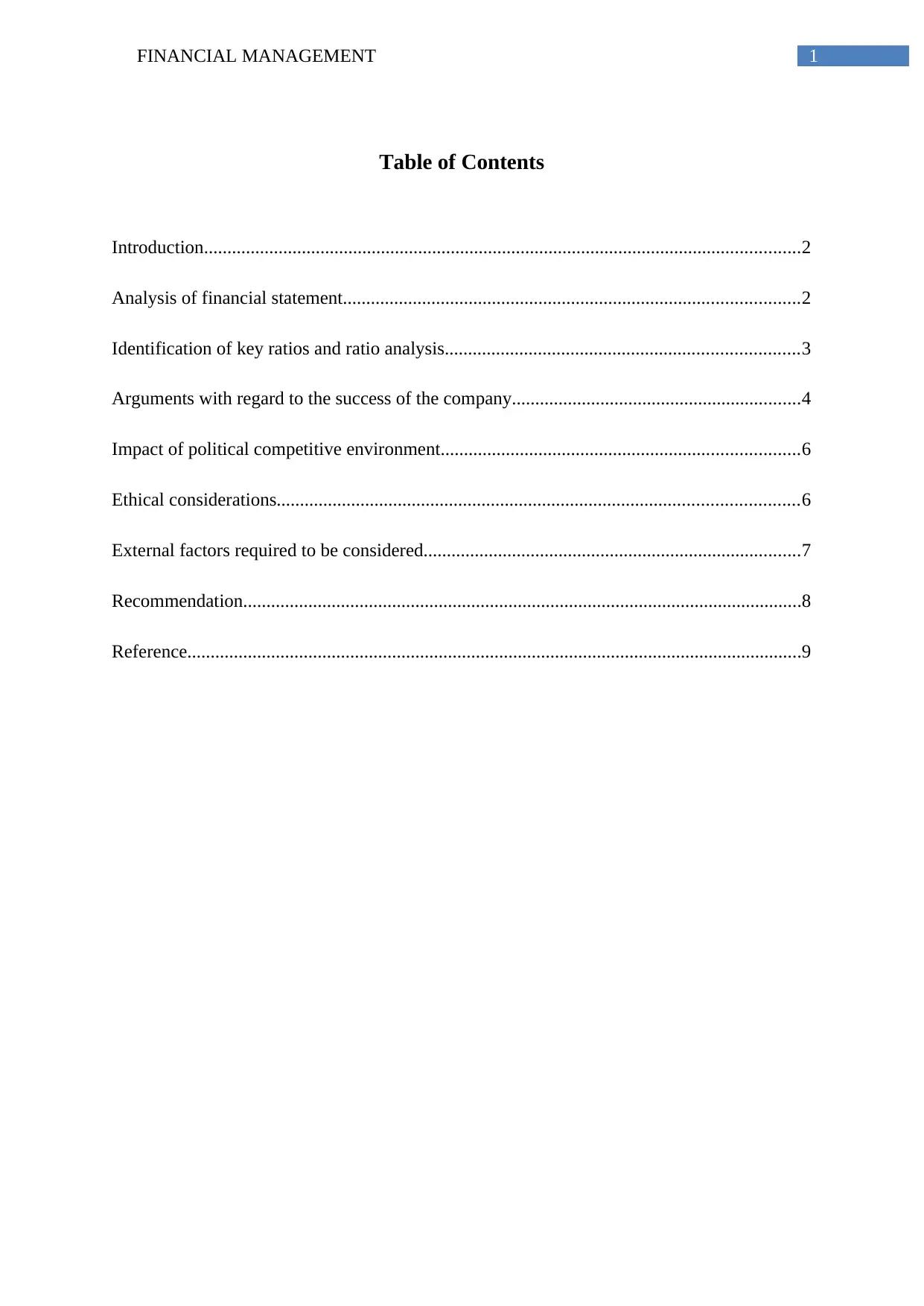
1FINANCIAL MANAGEMENT
Table of Contents
Introduction................................................................................................................................2
Analysis of financial statement..................................................................................................2
Identification of key ratios and ratio analysis............................................................................3
Arguments with regard to the success of the company..............................................................4
Impact of political competitive environment.............................................................................6
Ethical considerations................................................................................................................6
External factors required to be considered.................................................................................7
Recommendation........................................................................................................................8
Reference....................................................................................................................................9
Table of Contents
Introduction................................................................................................................................2
Analysis of financial statement..................................................................................................2
Identification of key ratios and ratio analysis............................................................................3
Arguments with regard to the success of the company..............................................................4
Impact of political competitive environment.............................................................................6
Ethical considerations................................................................................................................6
External factors required to be considered.................................................................................7
Recommendation........................................................................................................................8
Reference....................................................................................................................................9
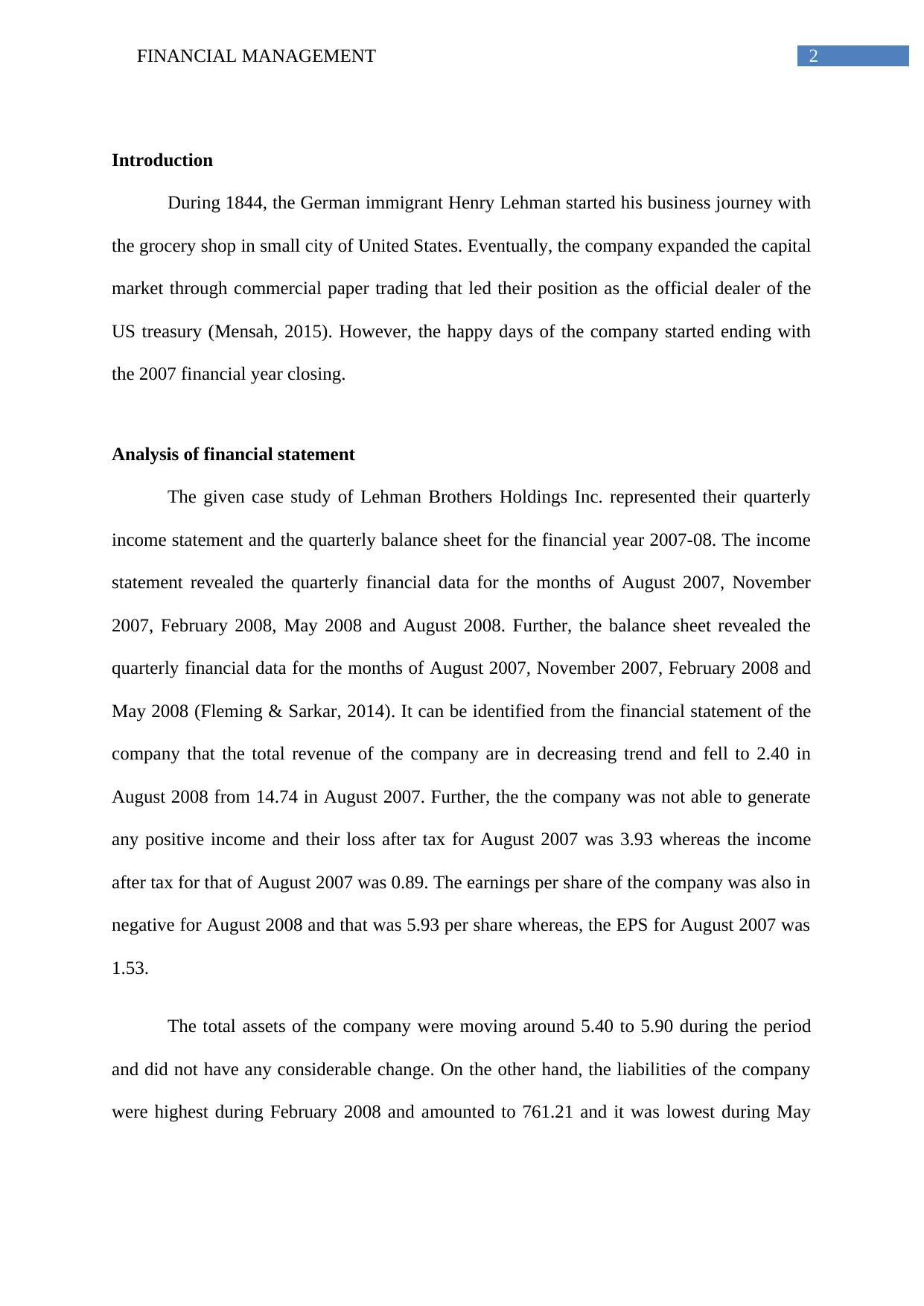
2FINANCIAL MANAGEMENT
Introduction
During 1844, the German immigrant Henry Lehman started his business journey with
the grocery shop in small city of United States. Eventually, the company expanded the capital
market through commercial paper trading that led their position as the official dealer of the
US treasury (Mensah, 2015). However, the happy days of the company started ending with
the 2007 financial year closing.
Analysis of financial statement
The given case study of Lehman Brothers Holdings Inc. represented their quarterly
income statement and the quarterly balance sheet for the financial year 2007-08. The income
statement revealed the quarterly financial data for the months of August 2007, November
2007, February 2008, May 2008 and August 2008. Further, the balance sheet revealed the
quarterly financial data for the months of August 2007, November 2007, February 2008 and
May 2008 (Fleming & Sarkar, 2014). It can be identified from the financial statement of the
company that the total revenue of the company are in decreasing trend and fell to 2.40 in
August 2008 from 14.74 in August 2007. Further, the the company was not able to generate
any positive income and their loss after tax for August 2007 was 3.93 whereas the income
after tax for that of August 2007 was 0.89. The earnings per share of the company was also in
negative for August 2008 and that was 5.93 per share whereas, the EPS for August 2007 was
1.53.
The total assets of the company were moving around 5.40 to 5.90 during the period
and did not have any considerable change. On the other hand, the liabilities of the company
were highest during February 2008 and amounted to 761.21 and it was lowest during May
Introduction
During 1844, the German immigrant Henry Lehman started his business journey with
the grocery shop in small city of United States. Eventually, the company expanded the capital
market through commercial paper trading that led their position as the official dealer of the
US treasury (Mensah, 2015). However, the happy days of the company started ending with
the 2007 financial year closing.
Analysis of financial statement
The given case study of Lehman Brothers Holdings Inc. represented their quarterly
income statement and the quarterly balance sheet for the financial year 2007-08. The income
statement revealed the quarterly financial data for the months of August 2007, November
2007, February 2008, May 2008 and August 2008. Further, the balance sheet revealed the
quarterly financial data for the months of August 2007, November 2007, February 2008 and
May 2008 (Fleming & Sarkar, 2014). It can be identified from the financial statement of the
company that the total revenue of the company are in decreasing trend and fell to 2.40 in
August 2008 from 14.74 in August 2007. Further, the the company was not able to generate
any positive income and their loss after tax for August 2007 was 3.93 whereas the income
after tax for that of August 2007 was 0.89. The earnings per share of the company was also in
negative for August 2008 and that was 5.93 per share whereas, the EPS for August 2007 was
1.53.
The total assets of the company were moving around 5.40 to 5.90 during the period
and did not have any considerable change. On the other hand, the liabilities of the company
were highest during February 2008 and amounted to 761.21 and it was lowest during May
⊘ This is a preview!⊘
Do you want full access?
Subscribe today to unlock all pages.

Trusted by 1+ million students worldwide
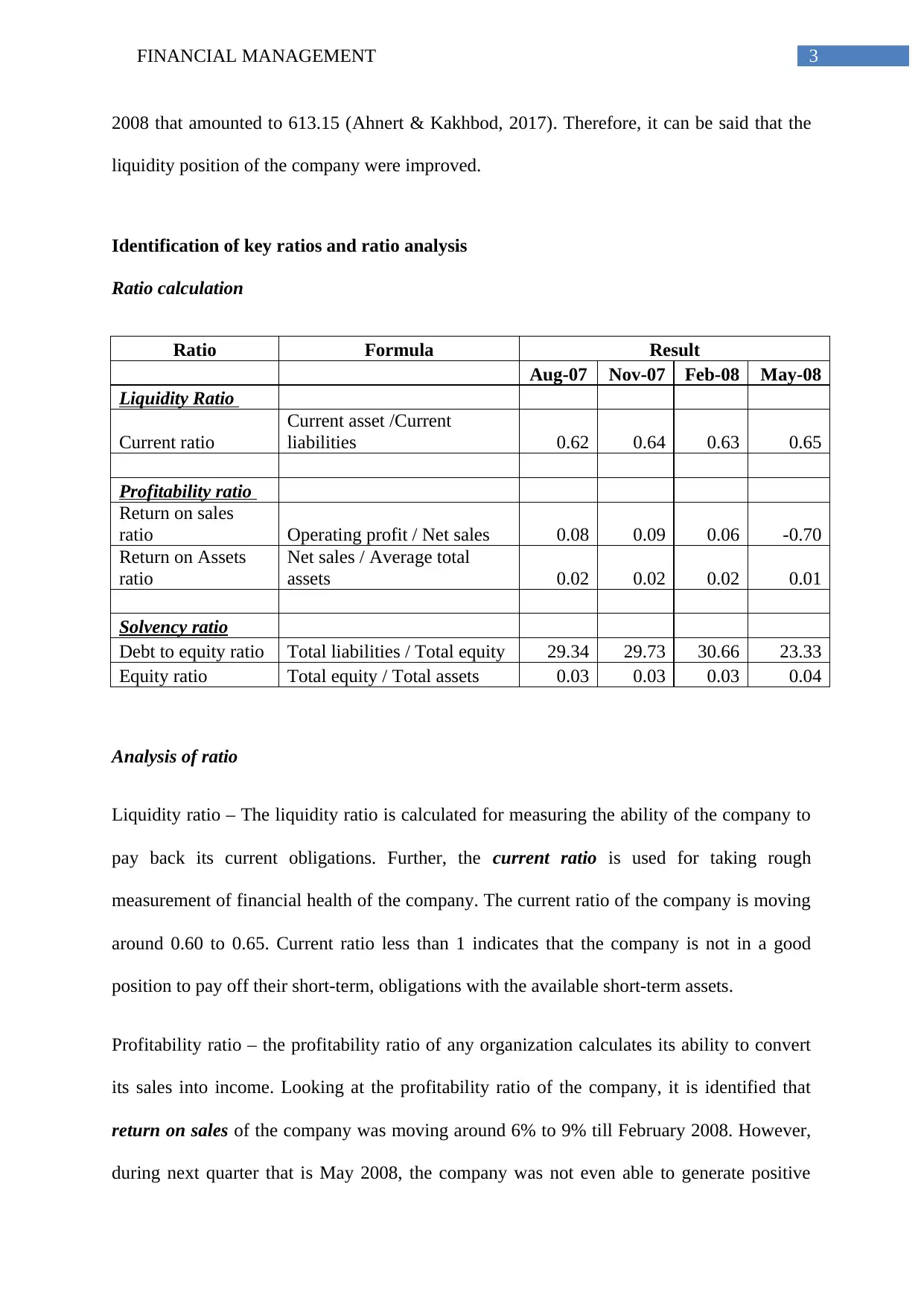
3FINANCIAL MANAGEMENT
2008 that amounted to 613.15 (Ahnert & Kakhbod, 2017). Therefore, it can be said that the
liquidity position of the company were improved.
Identification of key ratios and ratio analysis
Ratio calculation
Ratio Formula Result
Aug-07 Nov-07 Feb-08 May-08
Liquidity Ratio
Current ratio
Current asset /Current
liabilities 0.62 0.64 0.63 0.65
Profitability ratio
Return on sales
ratio Operating profit / Net sales 0.08 0.09 0.06 -0.70
Return on Assets
ratio
Net sales / Average total
assets 0.02 0.02 0.02 0.01
Solvency ratio
Debt to equity ratio Total liabilities / Total equity 29.34 29.73 30.66 23.33
Equity ratio Total equity / Total assets 0.03 0.03 0.03 0.04
Analysis of ratio
Liquidity ratio – The liquidity ratio is calculated for measuring the ability of the company to
pay back its current obligations. Further, the current ratio is used for taking rough
measurement of financial health of the company. The current ratio of the company is moving
around 0.60 to 0.65. Current ratio less than 1 indicates that the company is not in a good
position to pay off their short-term, obligations with the available short-term assets.
Profitability ratio – the profitability ratio of any organization calculates its ability to convert
its sales into income. Looking at the profitability ratio of the company, it is identified that
return on sales of the company was moving around 6% to 9% till February 2008. However,
during next quarter that is May 2008, the company was not even able to generate positive
2008 that amounted to 613.15 (Ahnert & Kakhbod, 2017). Therefore, it can be said that the
liquidity position of the company were improved.
Identification of key ratios and ratio analysis
Ratio calculation
Ratio Formula Result
Aug-07 Nov-07 Feb-08 May-08
Liquidity Ratio
Current ratio
Current asset /Current
liabilities 0.62 0.64 0.63 0.65
Profitability ratio
Return on sales
ratio Operating profit / Net sales 0.08 0.09 0.06 -0.70
Return on Assets
ratio
Net sales / Average total
assets 0.02 0.02 0.02 0.01
Solvency ratio
Debt to equity ratio Total liabilities / Total equity 29.34 29.73 30.66 23.33
Equity ratio Total equity / Total assets 0.03 0.03 0.03 0.04
Analysis of ratio
Liquidity ratio – The liquidity ratio is calculated for measuring the ability of the company to
pay back its current obligations. Further, the current ratio is used for taking rough
measurement of financial health of the company. The current ratio of the company is moving
around 0.60 to 0.65. Current ratio less than 1 indicates that the company is not in a good
position to pay off their short-term, obligations with the available short-term assets.
Profitability ratio – the profitability ratio of any organization calculates its ability to convert
its sales into income. Looking at the profitability ratio of the company, it is identified that
return on sales of the company was moving around 6% to 9% till February 2008. However,
during next quarter that is May 2008, the company was not even able to generate positive
Paraphrase This Document
Need a fresh take? Get an instant paraphrase of this document with our AI Paraphraser
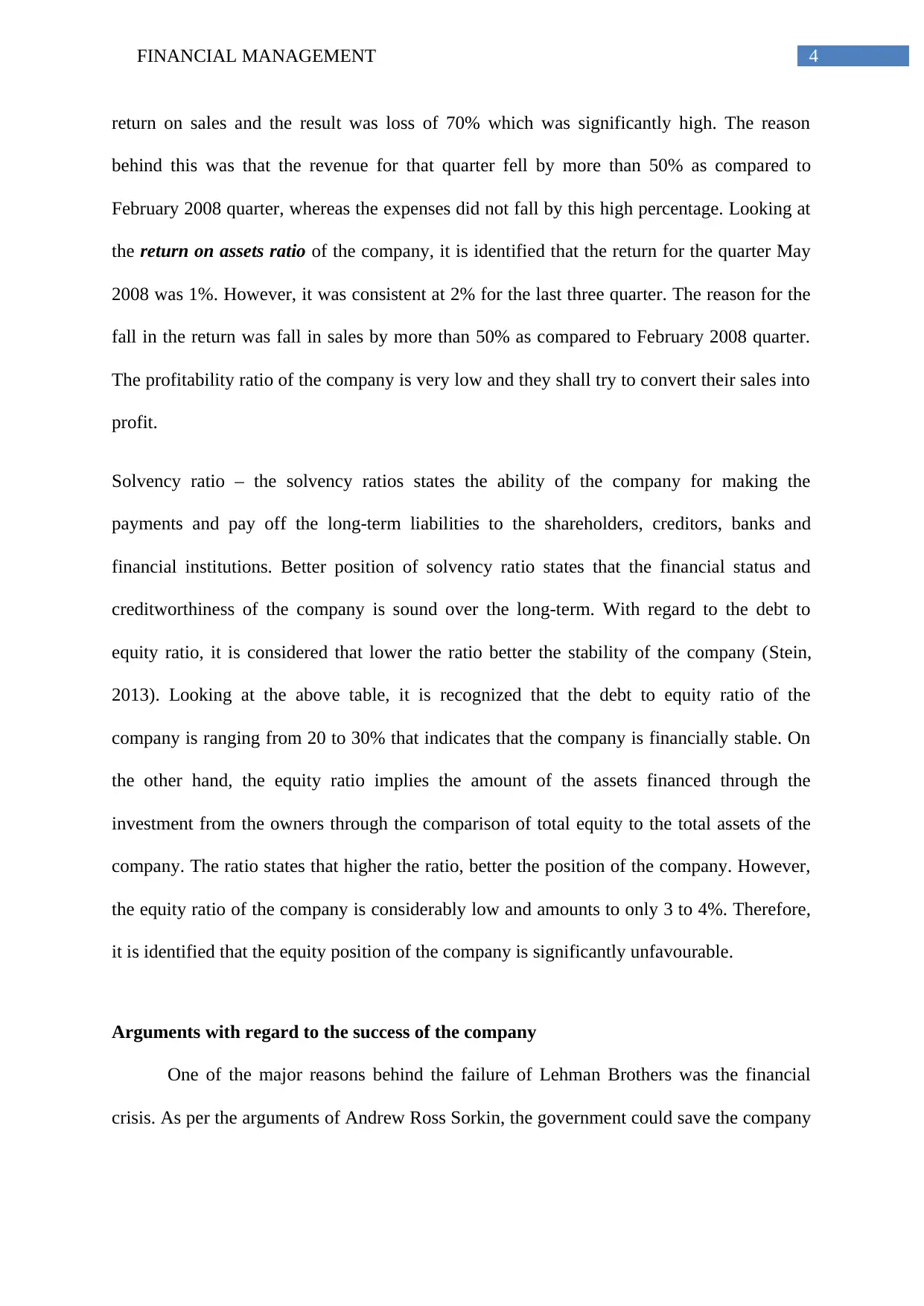
4FINANCIAL MANAGEMENT
return on sales and the result was loss of 70% which was significantly high. The reason
behind this was that the revenue for that quarter fell by more than 50% as compared to
February 2008 quarter, whereas the expenses did not fall by this high percentage. Looking at
the return on assets ratio of the company, it is identified that the return for the quarter May
2008 was 1%. However, it was consistent at 2% for the last three quarter. The reason for the
fall in the return was fall in sales by more than 50% as compared to February 2008 quarter.
The profitability ratio of the company is very low and they shall try to convert their sales into
profit.
Solvency ratio – the solvency ratios states the ability of the company for making the
payments and pay off the long-term liabilities to the shareholders, creditors, banks and
financial institutions. Better position of solvency ratio states that the financial status and
creditworthiness of the company is sound over the long-term. With regard to the debt to
equity ratio, it is considered that lower the ratio better the stability of the company (Stein,
2013). Looking at the above table, it is recognized that the debt to equity ratio of the
company is ranging from 20 to 30% that indicates that the company is financially stable. On
the other hand, the equity ratio implies the amount of the assets financed through the
investment from the owners through the comparison of total equity to the total assets of the
company. The ratio states that higher the ratio, better the position of the company. However,
the equity ratio of the company is considerably low and amounts to only 3 to 4%. Therefore,
it is identified that the equity position of the company is significantly unfavourable.
Arguments with regard to the success of the company
One of the major reasons behind the failure of Lehman Brothers was the financial
crisis. As per the arguments of Andrew Ross Sorkin, the government could save the company
return on sales and the result was loss of 70% which was significantly high. The reason
behind this was that the revenue for that quarter fell by more than 50% as compared to
February 2008 quarter, whereas the expenses did not fall by this high percentage. Looking at
the return on assets ratio of the company, it is identified that the return for the quarter May
2008 was 1%. However, it was consistent at 2% for the last three quarter. The reason for the
fall in the return was fall in sales by more than 50% as compared to February 2008 quarter.
The profitability ratio of the company is very low and they shall try to convert their sales into
profit.
Solvency ratio – the solvency ratios states the ability of the company for making the
payments and pay off the long-term liabilities to the shareholders, creditors, banks and
financial institutions. Better position of solvency ratio states that the financial status and
creditworthiness of the company is sound over the long-term. With regard to the debt to
equity ratio, it is considered that lower the ratio better the stability of the company (Stein,
2013). Looking at the above table, it is recognized that the debt to equity ratio of the
company is ranging from 20 to 30% that indicates that the company is financially stable. On
the other hand, the equity ratio implies the amount of the assets financed through the
investment from the owners through the comparison of total equity to the total assets of the
company. The ratio states that higher the ratio, better the position of the company. However,
the equity ratio of the company is considerably low and amounts to only 3 to 4%. Therefore,
it is identified that the equity position of the company is significantly unfavourable.
Arguments with regard to the success of the company
One of the major reasons behind the failure of Lehman Brothers was the financial
crisis. As per the arguments of Andrew Ross Sorkin, the government could save the company
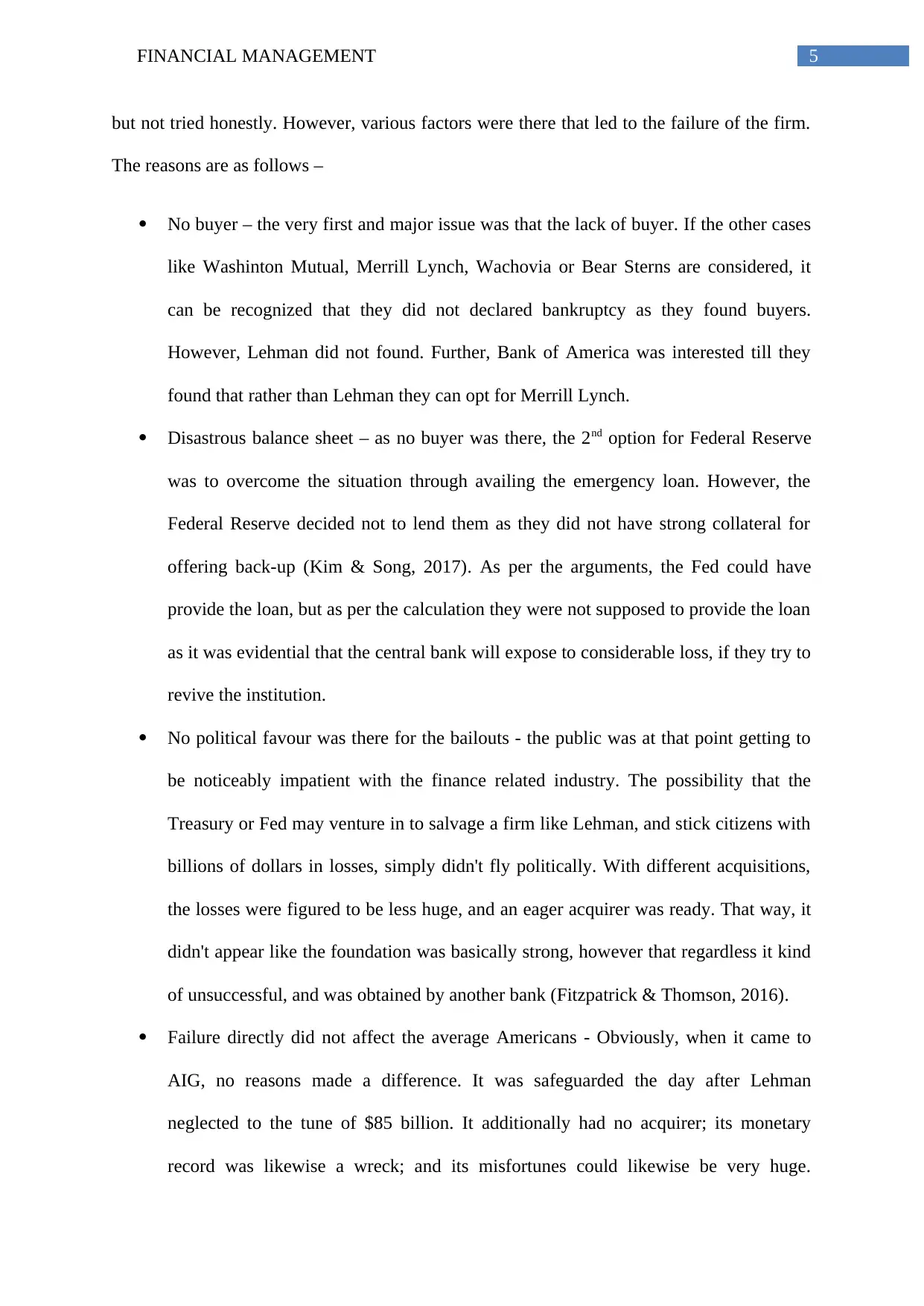
5FINANCIAL MANAGEMENT
but not tried honestly. However, various factors were there that led to the failure of the firm.
The reasons are as follows –
No buyer – the very first and major issue was that the lack of buyer. If the other cases
like Washinton Mutual, Merrill Lynch, Wachovia or Bear Sterns are considered, it
can be recognized that they did not declared bankruptcy as they found buyers.
However, Lehman did not found. Further, Bank of America was interested till they
found that rather than Lehman they can opt for Merrill Lynch.
Disastrous balance sheet – as no buyer was there, the 2nd option for Federal Reserve
was to overcome the situation through availing the emergency loan. However, the
Federal Reserve decided not to lend them as they did not have strong collateral for
offering back-up (Kim & Song, 2017). As per the arguments, the Fed could have
provide the loan, but as per the calculation they were not supposed to provide the loan
as it was evidential that the central bank will expose to considerable loss, if they try to
revive the institution.
No political favour was there for the bailouts - the public was at that point getting to
be noticeably impatient with the finance related industry. The possibility that the
Treasury or Fed may venture in to salvage a firm like Lehman, and stick citizens with
billions of dollars in losses, simply didn't fly politically. With different acquisitions,
the losses were figured to be less huge, and an eager acquirer was ready. That way, it
didn't appear like the foundation was basically strong, however that regardless it kind
of unsuccessful, and was obtained by another bank (Fitzpatrick & Thomson, 2016).
Failure directly did not affect the average Americans - Obviously, when it came to
AIG, no reasons made a difference. It was safeguarded the day after Lehman
neglected to the tune of $85 billion. It additionally had no acquirer; its monetary
record was likewise a wreck; and its misfortunes could likewise be very huge.
but not tried honestly. However, various factors were there that led to the failure of the firm.
The reasons are as follows –
No buyer – the very first and major issue was that the lack of buyer. If the other cases
like Washinton Mutual, Merrill Lynch, Wachovia or Bear Sterns are considered, it
can be recognized that they did not declared bankruptcy as they found buyers.
However, Lehman did not found. Further, Bank of America was interested till they
found that rather than Lehman they can opt for Merrill Lynch.
Disastrous balance sheet – as no buyer was there, the 2nd option for Federal Reserve
was to overcome the situation through availing the emergency loan. However, the
Federal Reserve decided not to lend them as they did not have strong collateral for
offering back-up (Kim & Song, 2017). As per the arguments, the Fed could have
provide the loan, but as per the calculation they were not supposed to provide the loan
as it was evidential that the central bank will expose to considerable loss, if they try to
revive the institution.
No political favour was there for the bailouts - the public was at that point getting to
be noticeably impatient with the finance related industry. The possibility that the
Treasury or Fed may venture in to salvage a firm like Lehman, and stick citizens with
billions of dollars in losses, simply didn't fly politically. With different acquisitions,
the losses were figured to be less huge, and an eager acquirer was ready. That way, it
didn't appear like the foundation was basically strong, however that regardless it kind
of unsuccessful, and was obtained by another bank (Fitzpatrick & Thomson, 2016).
Failure directly did not affect the average Americans - Obviously, when it came to
AIG, no reasons made a difference. It was safeguarded the day after Lehman
neglected to the tune of $85 billion. It additionally had no acquirer; its monetary
record was likewise a wreck; and its misfortunes could likewise be very huge.
⊘ This is a preview!⊘
Do you want full access?
Subscribe today to unlock all pages.

Trusted by 1+ million students worldwide
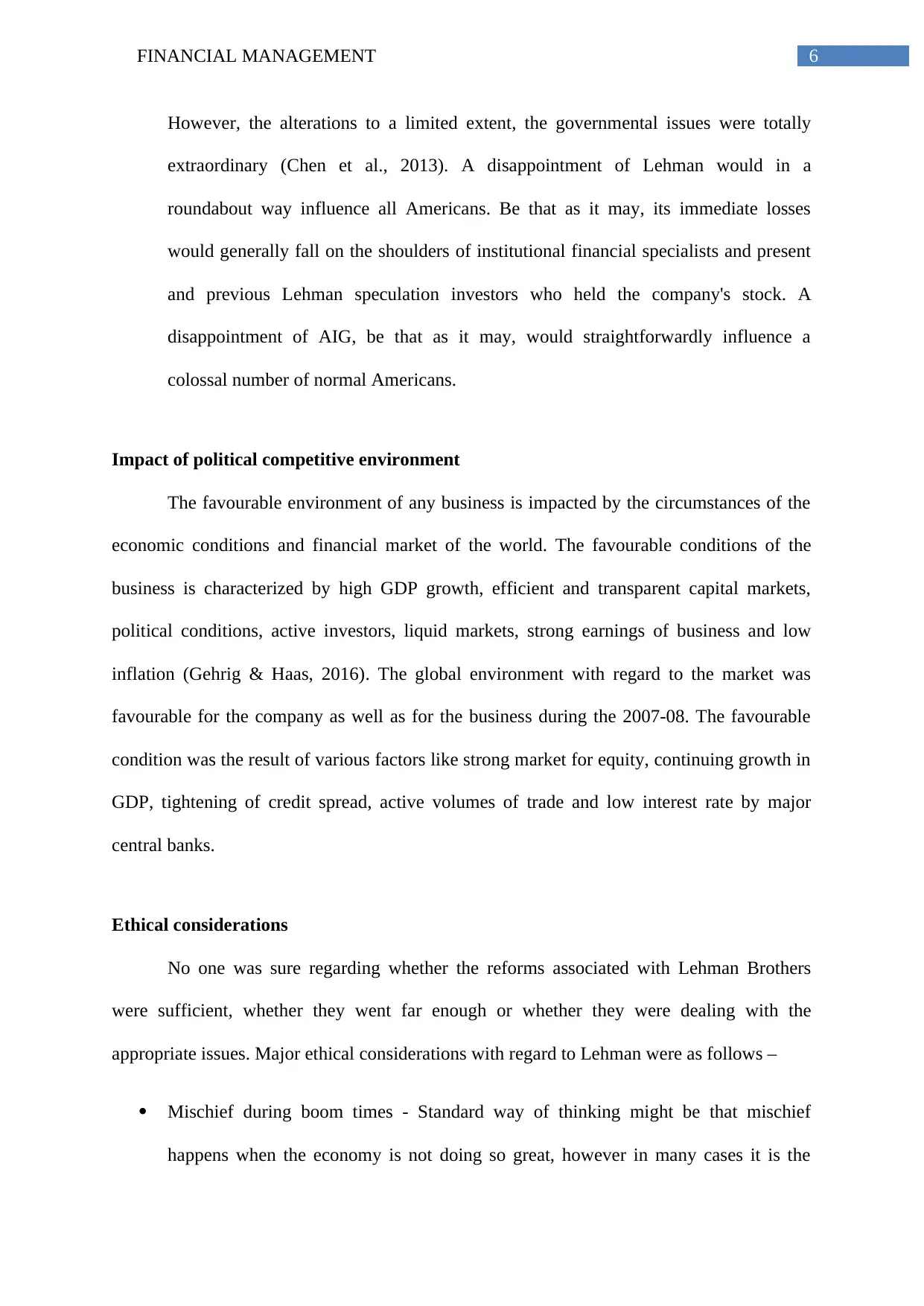
6FINANCIAL MANAGEMENT
However, the alterations to a limited extent, the governmental issues were totally
extraordinary (Chen et al., 2013). A disappointment of Lehman would in a
roundabout way influence all Americans. Be that as it may, its immediate losses
would generally fall on the shoulders of institutional financial specialists and present
and previous Lehman speculation investors who held the company's stock. A
disappointment of AIG, be that as it may, would straightforwardly influence a
colossal number of normal Americans.
Impact of political competitive environment
The favourable environment of any business is impacted by the circumstances of the
economic conditions and financial market of the world. The favourable conditions of the
business is characterized by high GDP growth, efficient and transparent capital markets,
political conditions, active investors, liquid markets, strong earnings of business and low
inflation (Gehrig & Haas, 2016). The global environment with regard to the market was
favourable for the company as well as for the business during the 2007-08. The favourable
condition was the result of various factors like strong market for equity, continuing growth in
GDP, tightening of credit spread, active volumes of trade and low interest rate by major
central banks.
Ethical considerations
No one was sure regarding whether the reforms associated with Lehman Brothers
were sufficient, whether they went far enough or whether they were dealing with the
appropriate issues. Major ethical considerations with regard to Lehman were as follows –
Mischief during boom times - Standard way of thinking might be that mischief
happens when the economy is not doing so great, however in many cases it is the
However, the alterations to a limited extent, the governmental issues were totally
extraordinary (Chen et al., 2013). A disappointment of Lehman would in a
roundabout way influence all Americans. Be that as it may, its immediate losses
would generally fall on the shoulders of institutional financial specialists and present
and previous Lehman speculation investors who held the company's stock. A
disappointment of AIG, be that as it may, would straightforwardly influence a
colossal number of normal Americans.
Impact of political competitive environment
The favourable environment of any business is impacted by the circumstances of the
economic conditions and financial market of the world. The favourable conditions of the
business is characterized by high GDP growth, efficient and transparent capital markets,
political conditions, active investors, liquid markets, strong earnings of business and low
inflation (Gehrig & Haas, 2016). The global environment with regard to the market was
favourable for the company as well as for the business during the 2007-08. The favourable
condition was the result of various factors like strong market for equity, continuing growth in
GDP, tightening of credit spread, active volumes of trade and low interest rate by major
central banks.
Ethical considerations
No one was sure regarding whether the reforms associated with Lehman Brothers
were sufficient, whether they went far enough or whether they were dealing with the
appropriate issues. Major ethical considerations with regard to Lehman were as follows –
Mischief during boom times - Standard way of thinking might be that mischief
happens when the economy is not doing so great, however in many cases it is the
Paraphrase This Document
Need a fresh take? Get an instant paraphrase of this document with our AI Paraphraser
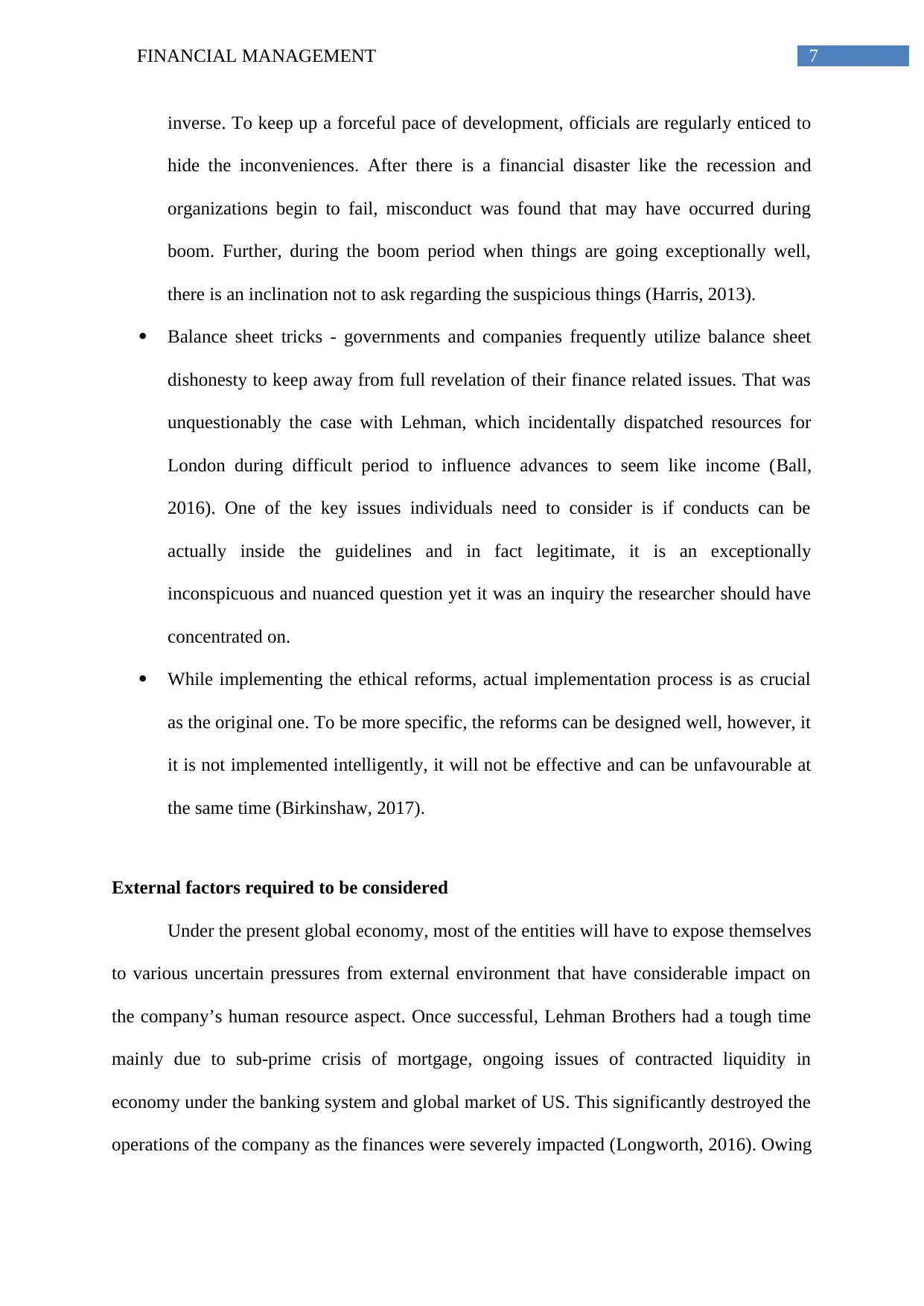
7FINANCIAL MANAGEMENT
inverse. To keep up a forceful pace of development, officials are regularly enticed to
hide the inconveniences. After there is a financial disaster like the recession and
organizations begin to fail, misconduct was found that may have occurred during
boom. Further, during the boom period when things are going exceptionally well,
there is an inclination not to ask regarding the suspicious things (Harris, 2013).
Balance sheet tricks - governments and companies frequently utilize balance sheet
dishonesty to keep away from full revelation of their finance related issues. That was
unquestionably the case with Lehman, which incidentally dispatched resources for
London during difficult period to influence advances to seem like income (Ball,
2016). One of the key issues individuals need to consider is if conducts can be
actually inside the guidelines and in fact legitimate, it is an exceptionally
inconspicuous and nuanced question yet it was an inquiry the researcher should have
concentrated on.
While implementing the ethical reforms, actual implementation process is as crucial
as the original one. To be more specific, the reforms can be designed well, however, it
it is not implemented intelligently, it will not be effective and can be unfavourable at
the same time (Birkinshaw, 2017).
External factors required to be considered
Under the present global economy, most of the entities will have to expose themselves
to various uncertain pressures from external environment that have considerable impact on
the company’s human resource aspect. Once successful, Lehman Brothers had a tough time
mainly due to sub-prime crisis of mortgage, ongoing issues of contracted liquidity in
economy under the banking system and global market of US. This significantly destroyed the
operations of the company as the finances were severely impacted (Longworth, 2016). Owing
inverse. To keep up a forceful pace of development, officials are regularly enticed to
hide the inconveniences. After there is a financial disaster like the recession and
organizations begin to fail, misconduct was found that may have occurred during
boom. Further, during the boom period when things are going exceptionally well,
there is an inclination not to ask regarding the suspicious things (Harris, 2013).
Balance sheet tricks - governments and companies frequently utilize balance sheet
dishonesty to keep away from full revelation of their finance related issues. That was
unquestionably the case with Lehman, which incidentally dispatched resources for
London during difficult period to influence advances to seem like income (Ball,
2016). One of the key issues individuals need to consider is if conducts can be
actually inside the guidelines and in fact legitimate, it is an exceptionally
inconspicuous and nuanced question yet it was an inquiry the researcher should have
concentrated on.
While implementing the ethical reforms, actual implementation process is as crucial
as the original one. To be more specific, the reforms can be designed well, however, it
it is not implemented intelligently, it will not be effective and can be unfavourable at
the same time (Birkinshaw, 2017).
External factors required to be considered
Under the present global economy, most of the entities will have to expose themselves
to various uncertain pressures from external environment that have considerable impact on
the company’s human resource aspect. Once successful, Lehman Brothers had a tough time
mainly due to sub-prime crisis of mortgage, ongoing issues of contracted liquidity in
economy under the banking system and global market of US. This significantly destroyed the
operations of the company as the finances were severely impacted (Longworth, 2016). Owing
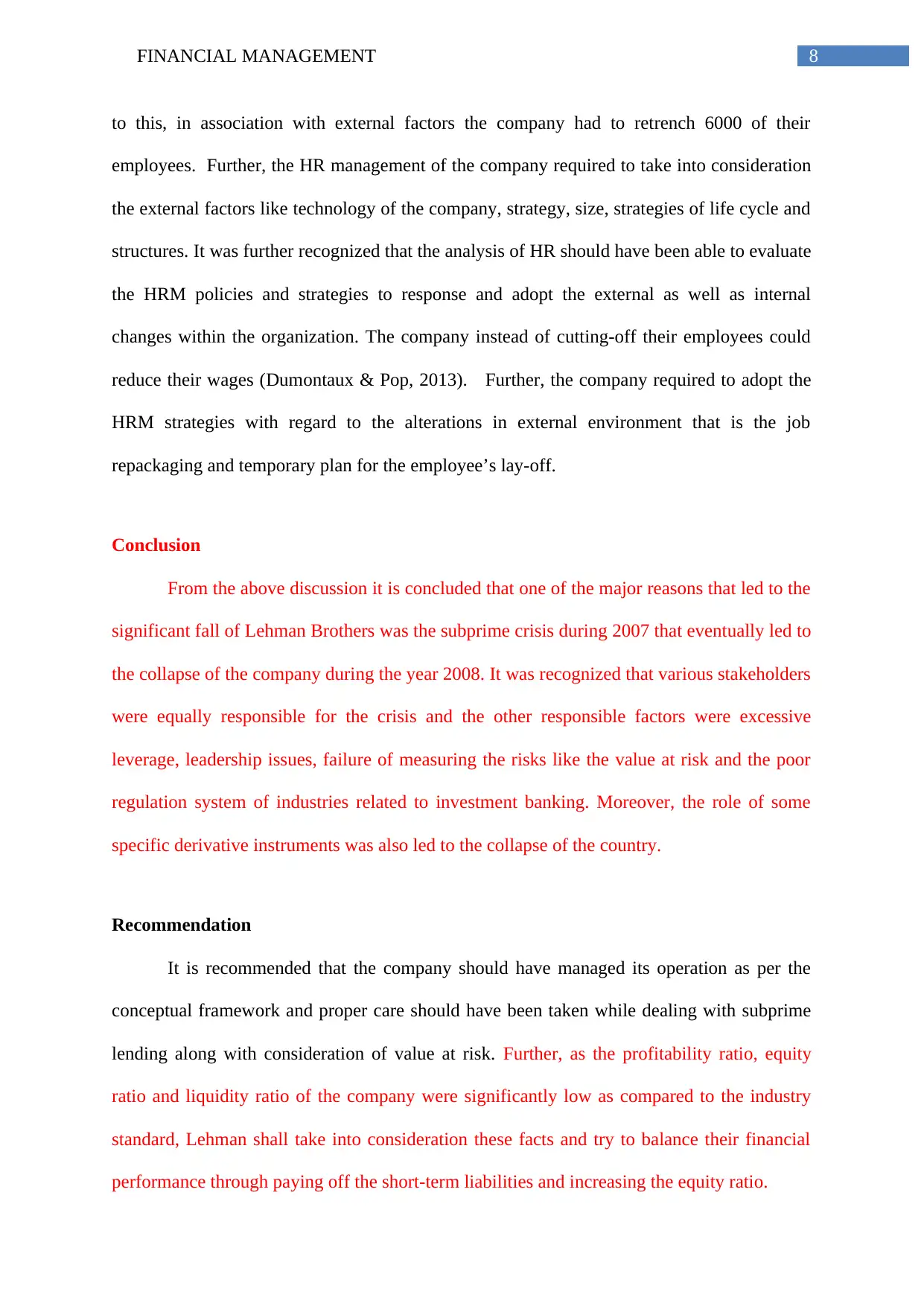
8FINANCIAL MANAGEMENT
to this, in association with external factors the company had to retrench 6000 of their
employees. Further, the HR management of the company required to take into consideration
the external factors like technology of the company, strategy, size, strategies of life cycle and
structures. It was further recognized that the analysis of HR should have been able to evaluate
the HRM policies and strategies to response and adopt the external as well as internal
changes within the organization. The company instead of cutting-off their employees could
reduce their wages (Dumontaux & Pop, 2013). Further, the company required to adopt the
HRM strategies with regard to the alterations in external environment that is the job
repackaging and temporary plan for the employee’s lay-off.
Conclusion
From the above discussion it is concluded that one of the major reasons that led to the
significant fall of Lehman Brothers was the subprime crisis during 2007 that eventually led to
the collapse of the company during the year 2008. It was recognized that various stakeholders
were equally responsible for the crisis and the other responsible factors were excessive
leverage, leadership issues, failure of measuring the risks like the value at risk and the poor
regulation system of industries related to investment banking. Moreover, the role of some
specific derivative instruments was also led to the collapse of the country.
Recommendation
It is recommended that the company should have managed its operation as per the
conceptual framework and proper care should have been taken while dealing with subprime
lending along with consideration of value at risk. Further, as the profitability ratio, equity
ratio and liquidity ratio of the company were significantly low as compared to the industry
standard, Lehman shall take into consideration these facts and try to balance their financial
performance through paying off the short-term liabilities and increasing the equity ratio.
to this, in association with external factors the company had to retrench 6000 of their
employees. Further, the HR management of the company required to take into consideration
the external factors like technology of the company, strategy, size, strategies of life cycle and
structures. It was further recognized that the analysis of HR should have been able to evaluate
the HRM policies and strategies to response and adopt the external as well as internal
changes within the organization. The company instead of cutting-off their employees could
reduce their wages (Dumontaux & Pop, 2013). Further, the company required to adopt the
HRM strategies with regard to the alterations in external environment that is the job
repackaging and temporary plan for the employee’s lay-off.
Conclusion
From the above discussion it is concluded that one of the major reasons that led to the
significant fall of Lehman Brothers was the subprime crisis during 2007 that eventually led to
the collapse of the company during the year 2008. It was recognized that various stakeholders
were equally responsible for the crisis and the other responsible factors were excessive
leverage, leadership issues, failure of measuring the risks like the value at risk and the poor
regulation system of industries related to investment banking. Moreover, the role of some
specific derivative instruments was also led to the collapse of the country.
Recommendation
It is recommended that the company should have managed its operation as per the
conceptual framework and proper care should have been taken while dealing with subprime
lending along with consideration of value at risk. Further, as the profitability ratio, equity
ratio and liquidity ratio of the company were significantly low as compared to the industry
standard, Lehman shall take into consideration these facts and try to balance their financial
performance through paying off the short-term liabilities and increasing the equity ratio.
⊘ This is a preview!⊘
Do you want full access?
Subscribe today to unlock all pages.

Trusted by 1+ million students worldwide
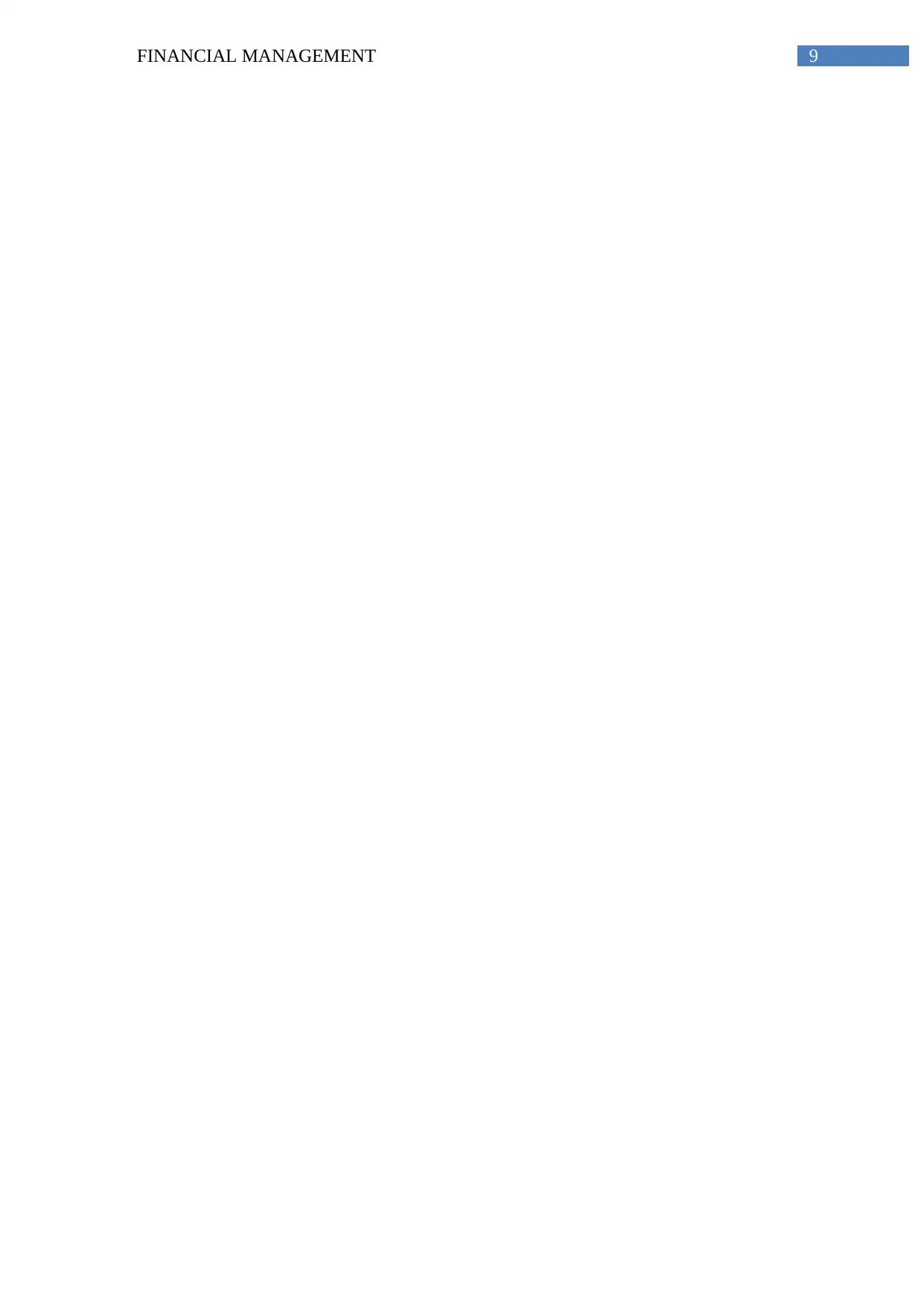
9FINANCIAL MANAGEMENT
Paraphrase This Document
Need a fresh take? Get an instant paraphrase of this document with our AI Paraphraser
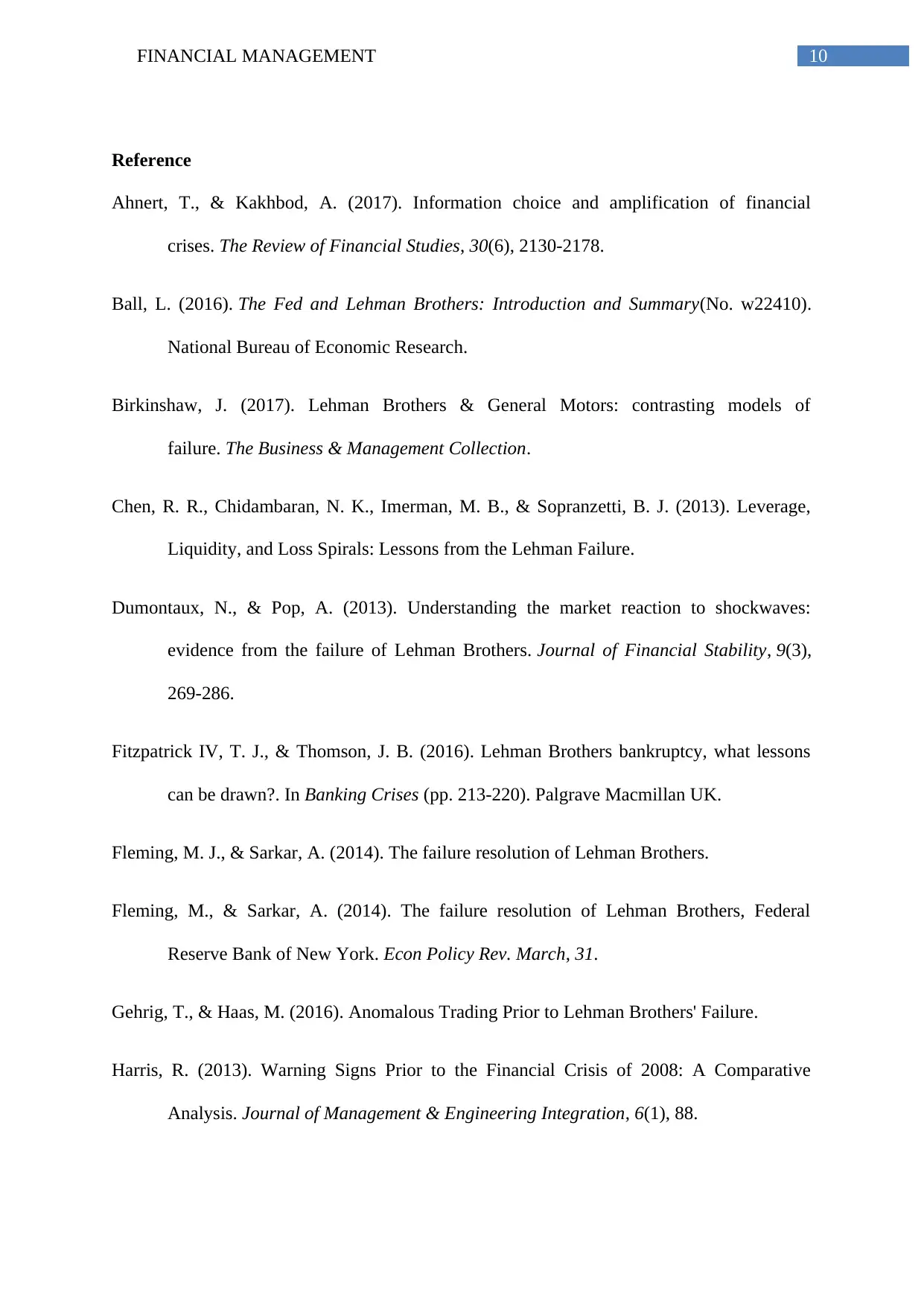
10FINANCIAL MANAGEMENT
Reference
Ahnert, T., & Kakhbod, A. (2017). Information choice and amplification of financial
crises. The Review of Financial Studies, 30(6), 2130-2178.
Ball, L. (2016). The Fed and Lehman Brothers: Introduction and Summary(No. w22410).
National Bureau of Economic Research.
Birkinshaw, J. (2017). Lehman Brothers & General Motors: contrasting models of
failure. The Business & Management Collection.
Chen, R. R., Chidambaran, N. K., Imerman, M. B., & Sopranzetti, B. J. (2013). Leverage,
Liquidity, and Loss Spirals: Lessons from the Lehman Failure.
Dumontaux, N., & Pop, A. (2013). Understanding the market reaction to shockwaves:
evidence from the failure of Lehman Brothers. Journal of Financial Stability, 9(3),
269-286.
Fitzpatrick IV, T. J., & Thomson, J. B. (2016). Lehman Brothers bankruptcy, what lessons
can be drawn?. In Banking Crises (pp. 213-220). Palgrave Macmillan UK.
Fleming, M. J., & Sarkar, A. (2014). The failure resolution of Lehman Brothers.
Fleming, M., & Sarkar, A. (2014). The failure resolution of Lehman Brothers, Federal
Reserve Bank of New York. Econ Policy Rev. March, 31.
Gehrig, T., & Haas, M. (2016). Anomalous Trading Prior to Lehman Brothers' Failure.
Harris, R. (2013). Warning Signs Prior to the Financial Crisis of 2008: A Comparative
Analysis. Journal of Management & Engineering Integration, 6(1), 88.
Reference
Ahnert, T., & Kakhbod, A. (2017). Information choice and amplification of financial
crises. The Review of Financial Studies, 30(6), 2130-2178.
Ball, L. (2016). The Fed and Lehman Brothers: Introduction and Summary(No. w22410).
National Bureau of Economic Research.
Birkinshaw, J. (2017). Lehman Brothers & General Motors: contrasting models of
failure. The Business & Management Collection.
Chen, R. R., Chidambaran, N. K., Imerman, M. B., & Sopranzetti, B. J. (2013). Leverage,
Liquidity, and Loss Spirals: Lessons from the Lehman Failure.
Dumontaux, N., & Pop, A. (2013). Understanding the market reaction to shockwaves:
evidence from the failure of Lehman Brothers. Journal of Financial Stability, 9(3),
269-286.
Fitzpatrick IV, T. J., & Thomson, J. B. (2016). Lehman Brothers bankruptcy, what lessons
can be drawn?. In Banking Crises (pp. 213-220). Palgrave Macmillan UK.
Fleming, M. J., & Sarkar, A. (2014). The failure resolution of Lehman Brothers.
Fleming, M., & Sarkar, A. (2014). The failure resolution of Lehman Brothers, Federal
Reserve Bank of New York. Econ Policy Rev. March, 31.
Gehrig, T., & Haas, M. (2016). Anomalous Trading Prior to Lehman Brothers' Failure.
Harris, R. (2013). Warning Signs Prior to the Financial Crisis of 2008: A Comparative
Analysis. Journal of Management & Engineering Integration, 6(1), 88.
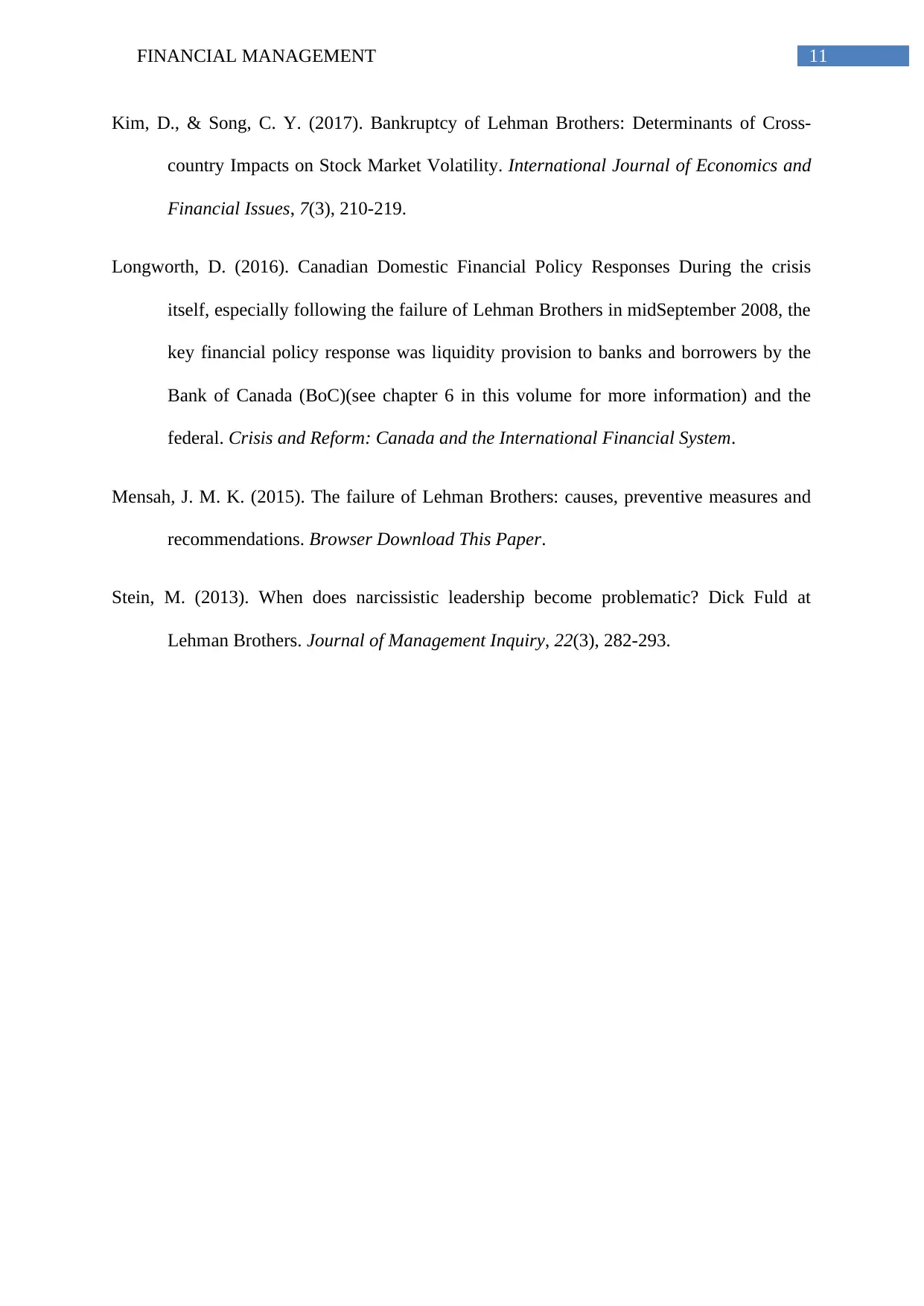
11FINANCIAL MANAGEMENT
Kim, D., & Song, C. Y. (2017). Bankruptcy of Lehman Brothers: Determinants of Cross-
country Impacts on Stock Market Volatility. International Journal of Economics and
Financial Issues, 7(3), 210-219.
Longworth, D. (2016). Canadian Domestic Financial Policy Responses During the crisis
itself, especially following the failure of Lehman Brothers in midSeptember 2008, the
key financial policy response was liquidity provision to banks and borrowers by the
Bank of Canada (BoC)(see chapter 6 in this volume for more information) and the
federal. Crisis and Reform: Canada and the International Financial System.
Mensah, J. M. K. (2015). The failure of Lehman Brothers: causes, preventive measures and
recommendations. Browser Download This Paper.
Stein, M. (2013). When does narcissistic leadership become problematic? Dick Fuld at
Lehman Brothers. Journal of Management Inquiry, 22(3), 282-293.
Kim, D., & Song, C. Y. (2017). Bankruptcy of Lehman Brothers: Determinants of Cross-
country Impacts on Stock Market Volatility. International Journal of Economics and
Financial Issues, 7(3), 210-219.
Longworth, D. (2016). Canadian Domestic Financial Policy Responses During the crisis
itself, especially following the failure of Lehman Brothers in midSeptember 2008, the
key financial policy response was liquidity provision to banks and borrowers by the
Bank of Canada (BoC)(see chapter 6 in this volume for more information) and the
federal. Crisis and Reform: Canada and the International Financial System.
Mensah, J. M. K. (2015). The failure of Lehman Brothers: causes, preventive measures and
recommendations. Browser Download This Paper.
Stein, M. (2013). When does narcissistic leadership become problematic? Dick Fuld at
Lehman Brothers. Journal of Management Inquiry, 22(3), 282-293.
⊘ This is a preview!⊘
Do you want full access?
Subscribe today to unlock all pages.

Trusted by 1+ million students worldwide
1 out of 12
Related Documents
Your All-in-One AI-Powered Toolkit for Academic Success.
+13062052269
info@desklib.com
Available 24*7 on WhatsApp / Email
![[object Object]](/_next/static/media/star-bottom.7253800d.svg)
Unlock your academic potential
Copyright © 2020–2025 A2Z Services. All Rights Reserved. Developed and managed by ZUCOL.





